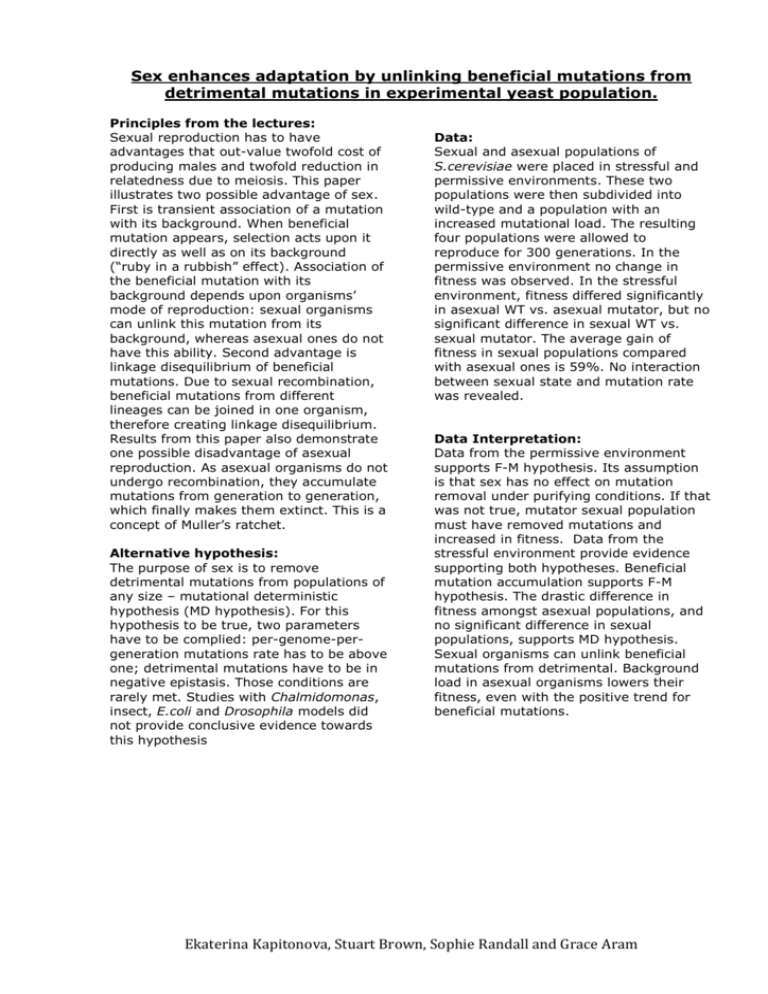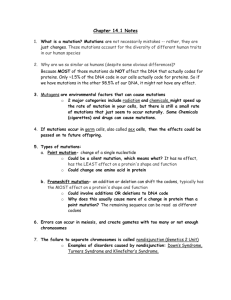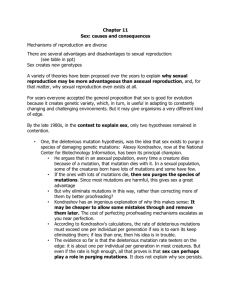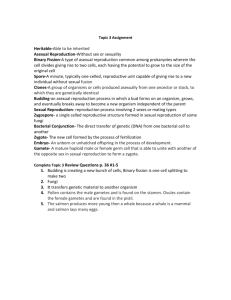
Sex enhances adaptation by unlinking beneficial mutations from
detrimental mutations in experimental yeast population.
Principles from the lectures:
Sexual reproduction has to have
advantages that out-value twofold cost of
producing males and twofold reduction in
relatedness due to meiosis. This paper
illustrates two possible advantage of sex.
First is transient association of a mutation
with its background. When beneficial
mutation appears, selection acts upon it
directly as well as on its background
(“ruby in a rubbish” effect). Association of
the beneficial mutation with its
background depends upon organisms’
mode of reproduction: sexual organisms
can unlink this mutation from its
background, whereas asexual ones do not
have this ability. Second advantage is
linkage disequilibrium of beneficial
mutations. Due to sexual recombination,
beneficial mutations from different
lineages can be joined in one organism,
therefore creating linkage disequilibrium.
Results from this paper also demonstrate
one possible disadvantage of asexual
reproduction. As asexual organisms do not
undergo recombination, they accumulate
mutations from generation to generation,
which finally makes them extinct. This is a
concept of Muller’s ratchet.
Alternative hypothesis:
The purpose of sex is to remove
detrimental mutations from populations of
any size – mutational deterministic
hypothesis (MD hypothesis). For this
hypothesis to be true, two parameters
have to be complied: per-genome-pergeneration mutations rate has to be above
one; detrimental mutations have to be in
negative epistasis. Those conditions are
rarely met. Studies with Chalmidomonas,
insect, E.coli and Drosophila models did
not provide conclusive evidence towards
this hypothesis
Data:
Sexual and asexual populations of
S.cerevisiae were placed in stressful and
permissive environments. These two
populations were then subdivided into
wild-type and a population with an
increased mutational load. The resulting
four populations were allowed to
reproduce for 300 generations. In the
permissive environment no change in
fitness was observed. In the stressful
environment, fitness differed significantly
in asexual WT vs. asexual mutator, but no
significant difference in sexual WT vs.
sexual mutator. The average gain of
fitness in sexual populations compared
with asexual ones is 59%. No interaction
between sexual state and mutation rate
was revealed.
Data Interpretation:
Data from the permissive environment
supports F-M hypothesis. Its assumption
is that sex has no effect on mutation
removal under purifying conditions. If that
was not true, mutator sexual population
must have removed mutations and
increased in fitness. Data from the
stressful environment provide evidence
supporting both hypotheses. Beneficial
mutation accumulation supports F-M
hypothesis. The drastic difference in
fitness amongst asexual populations, and
no significant difference in sexual
populations, supports MD hypothesis.
Sexual organisms can unlink beneficial
mutations from detrimental. Background
load in asexual organisms lowers their
fitness, even with the positive trend for
beneficial mutations.
Ekaterina Kapitonova, Stuart Brown, Sophie Randall and Grace Aram
Figure 1: Malthusian (log) fitness that shows fitness gain in sexual vs. asexual populations after
300 generations
Ekaterina Kapitonova, Stuart Brown, Sophie Randall and Grace Aram










